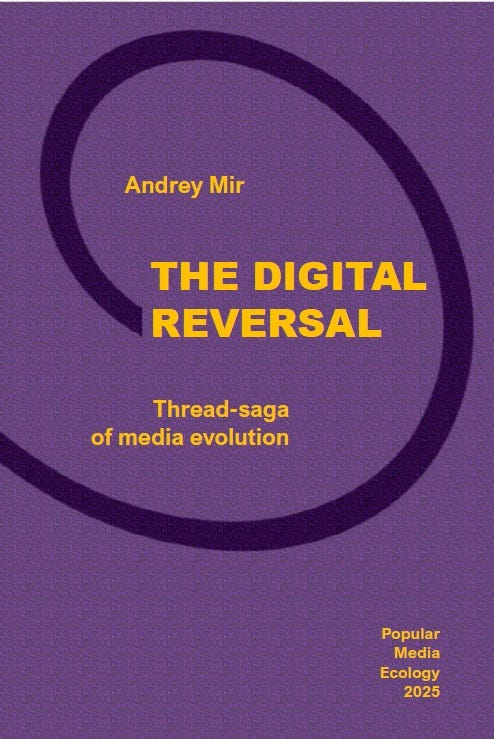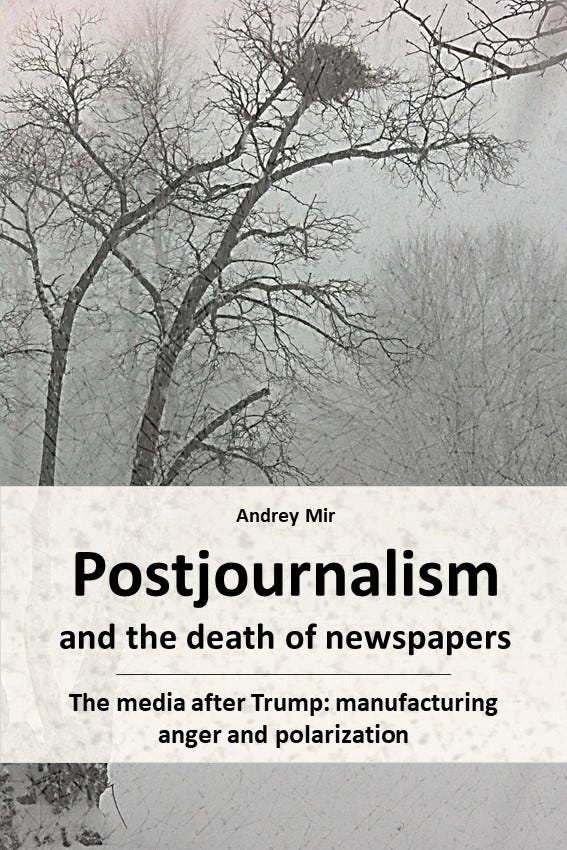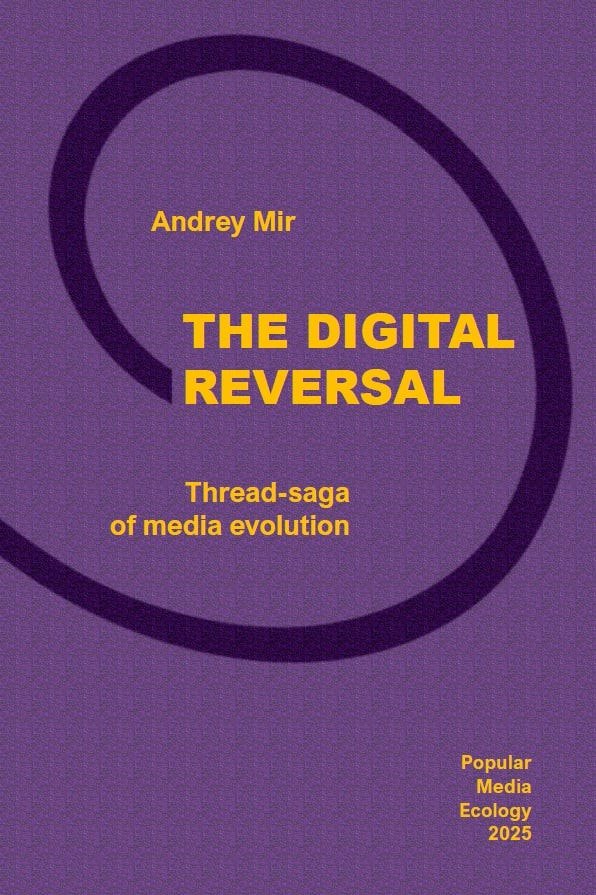The Digital Reversal. Thread-saga of Media Evolution—just published!
The future of the book is the blurb, said Marshall McLuhan. As the future arrives, this book is written in tweets—1,295 of them. Structured in thread-chapters, they explore and explain what media evolution has done to us. Read more in: The Digital Reversal. Thread-saga of Media Evolution (just published!).
“Reversals, reversals everywhere!”—occurred to me when I finished Digital Future in the Rearview Mirror.[i] I explored how digital media reverse literacy and retrieve orality. Once the lens was designed, I looked through it and saw that digital media reverse everything else.
The abundance of signals reverses into noise. The abundance of facts reverses into fakes. Free access to self-expression on social media leads to abuse by trolls and bad actors and reverses into censorship. The revolt of the public reverses into anarcho-tyranny.
The abundance of choices flips into decision paralysis. The overload of news reverses into news fatigue and news avoidance. The collective mechanism of content selection—the Viral Editor—reverses into collective content policing: the Viral Inquisitor[ii] that watches you.
Put to use in digital conversation, text reverses into texting and reverses delayed, solitary reasoning into impulsive exchange. Abstraction reverses into anecdotal evidence. Feelings reverse into intensities. Boosted by empathy overload, identity reverses into credentials.
Print-based literacy reverses into digital orality.[iii] Reading books reverses into asking the search box. Knowledge reverses into knowing. Escalated by digital media, academia flips into activism. Objective truth reverses into crowdsourced importance.
The business of news media reversed from plentiful ad revenue to desperately seeking digital subscriptions. This business shift reverses news supply into news validation. Journalism reverses into postjournalism,[iv] reversing professional standards from impartiality to activism.
Patriarchy reverses into feminism, and feminism reverses into gender fluidity. The camera enabled capturing reality but eventually reversed its effect into staging reality for the camera to capture. The society of the spectacle reverses into the digital carnival.
And so on and so forth. It dawned on me: reversal may be the key to understanding the digital era, when everything flips or reverses into its opposite. Reversals are the invisible hand of digital media—the dominant pattern of social change in our era.
***
To the general public, reversal means turning into the opposite, beginning a backward move, or undoing something. But in media ecology, reversal is a concept introduced by Marshall McLuhan as one of the four Laws of Media: enhancement, obsolescence, retrieval, and reversal.[v]
According to McLuhan, when a medium or technology is pushed to its extremes or reaches its limits, its full potential, it tends to flip or reverse its characteristics or effects into something different, often opposite.
The clearest example is the effect of cars. Cars enhance mobility and transportation. But when there are too many of them, their effect reverses from speed and freedom to the opposite: traffic jams.
Why does reversal stand out among other media effects (Laws of Media) in the digital era? As McLuhan wrote, “At electric speed, all forms are pushed to the limits of their potential.”[vi] Reaching limits is a prerequisite for reversal. Electric speed invited reversals.
Now, society lives at digital speed. Not just communication, but nearly all human activities are digitized. Digital speed is the ultimate speed of social interaction. So, everything digital is “pushed to the limits of its potential”—and this is the trigger for reversals.
Another limit we are approaching has to do with demographics. Internet use has reached nearly 100% of the population in many countries and is nearing this level in many others. This—reaching the demographic limits of proliferation—is also a condition for reversals.
The logic of media is implacable: if digital media reach everyone and everything, and speed up social interactions to their maximal intensity, an environmental affordance emerges that allows—and actually dictates—reversing and flipping many things into their opposites.
That is why we are living not just through the era of digital transformation, but through the era of digital reversal. One tectonic reversal—the Digital Reversal—consists of countless reversals across all aspects of human life.
***
This book is about the Digital Reversal as the hallmark of the era, and the digital reversals that fuel it. I use the optic of reversal to examine old ideas, like digital orality and the Viral Inquisitor, and to develop new ones, like intellectual escalation and gender reversal.
To suit both digital orality and digital reversal, the book itself is a reversal—from the long, “monumental” writing of the 20th century to a more digital form: the entire text is written in tweets. Each paragraph does not exceed 280 characters. The book contains 1,295 tweets.
It is a reversal of treatise into tweetise, a thread-saga attempting to marry Homer, Wittgenstein, and digital orality. McLuhan once said that the future of the book is the blurb. Before books finally collapse into blurbs, let’s try threads of tweets.
In fiction, it’s called “twitterature.” My friend and colleague Robert K. Blechman used it in his Twistery Twilogy.[vii] In non-fiction, nobody seemed to try it—except Wittgenstein, who wrote his Tractatus Logico-Philosophicus in short, numbered statements a century before Twitter.[viii]
Unlike actual tweets that serve impulsive conversational exchange on social media, these tweets are gathered in long threads to express a book-long narrative. They are not conversational; their “digital orality” is confined to their limited, almost rhythmic structure.
For Homer, the metric pattern of hexameter enabled improvisation and memorization—for better packaging and delivery under the conditions of orality. I hope the metric pattern of a tweet, 280 characters, can help with better packaging and delivery in the era of digital orality.
Although diced into tweets, this tweetise covers media eras—hence the “saga.” Even if not as poetic as Homer or as logical as Wittgenstein, the book seems to pick up some rhythm from its tweet-verses. Anyway, without the discipline of the form, it would be three times longer.
At digital speed, thoughts reverse into tweets and reasoning into threads. Both retrieve oral rhapsodia—Greek for stitching song from improvised but formulaic verses. That’s what made this project: stitching tweet-verses into a thread-saga—a reversal of the book.
The book explores digital reversals in bundles: media reversals, value reversals, epistemological reversals, sensory-cognitive reversals, cultural reversals, and the reversal of humankind itself.
Read more in: The Digital Reversal. Thread-saga of Media Evolution—just published! Available on Amazon.
The Table of Contents
Foreword
-1. The historic historical reversal: Replaying history backward
0. The rule of reversal, or Why reversals rule the Digital Era
Reversals and the Tetrad of media effects
The power of reversal
Reversal in understanding media
Patterns of reversals
Accelerated time and the tsunami of reversals
1. Media reversals
The emancipation of authorship: The reversal of content consumers into content producers
The Revolt of the Public: The reversal from the Pyramid to the Cloud
The blogosphere and the Viral Editor: The reversal from editing to co-editing reality
Postjournalism: The reversal of the media from news supply to news validation
Social media and the Viral Inquisitor: The reversal from content to attitude
Digital orality: The flip of text into texting
Platform effect: The reversal of convenience into slavery
2. Value Reversals
The Digital Rush of the 2010s: Discourse reversal
Fallout of media targeting: The reversal of identity into credentials
From free access to abuse: The reversal of free speech into censorship
Empathy reversal: From maintaining tribal unity to virtue signaling
The Revolt of the Public reversed: From digital freedom to digital control
3. Epistemological Reversals
How we acquire knowledge: The reversal from reading to asking
Abstraction vs. experiencing: The reversal of knowledge into knowing
Post-truth: The reversal from objectivity to subjectivity
Crowdsourced truth: The reversal of truth into significance
4. Sensory-Cognitive Reversals
From books to scrolling: The reversal from structuring to the flow
The screen effect: The reversal of light
The click effect: The reversal of effort
Digital sensorium: From natural to virtual
Social sensorium: The reversal of feelings into digital senses
Digital habitat: The reversal from body extensions to extending the self
The time-space reversal: From colonizing space to taming time
5. Cultural Reversals
Intellectual escalation: The reversal of academia into activism
Feminism as a media effect and the chain of gender reversals
The reversal of the electronic spectacle into the digital carnival
The reversal of feelings into intensities
The reversal of engagement into avoidance
The totality and selectivity of the digital reversal
6. The Reversal of Humankind
The reversal of everything: When the environment is faster than human neurons
The reversal of explosion into implosion: AI as the true affordance of digital media
The reversal of human agency: The technological imperative
Anti-environmental counter-digital media literacy: A much-needed reversal
See also books by Andrey Mir:
The Viral Inquisitor and other essays on postjournalism and media ecology (2024)
Digital Future in the Rearview Mirror: Jaspers’ Axial Age and Logan’s Alphabet Effect (2024)
[i] Mir, Andrey. (2024). Digital Future in the Rearview Mirror: Jaspers’ Axial Age and Logan’s Alphabet Effect.
[ii] Mir, Andrey. (2024). The Viral Inquisitor and other essays on postjournalism and media ecology.
[iii] Mir, Andrey. (2024). Digital Future in the Rearview Mirror: Jaspers’ Axial Age and Logan’s Alphabet Effect.
[iv] Mir, Andrey. (2020). Postjournalism and the Death of Newspapers. The Media after Trump: Manufacturing Anger and Polarization.
[v] McLuhan, Marshall, and McLuhan, Eric. (1988). Laws of Media: The New Science.
[vi] McLuhan, Marshall, and McLuhan, Eric. (1988). Laws of Media: The New Science. P. 109.
[vii] Blechman, Robert K. The Twistery Twilogy series: Executive Severance (2011), The Golden Parachute (2016), and I Tweet, Therefore I Am (2017).
[viii] Guy Debord, in his 1967 The Society of the Spectacle, and a few others also used short, declarative theses to organize narrative—but without fixed length limits or consistent discipline. It was more like the genre of manifesto.








Cool idea for a book. Do you help run Popular Media Ecology? Also, why does it seem like Retrieve is the hardest quadrant in the tetrad?